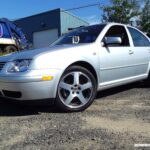Experiencing a P0430 code can be frustrating for any car owner. This trouble code signals an issue with your vehicle’s catalytic converter efficiency, specifically on Bank 2. Let’s break down what the P0430 code means, focusing on the often-misunderstood Bank 2 location, and explore potential fixes based on real-world experiences.
The P0430 code, as indicated by an OBD-II scanner, means “Catalyst System Efficiency Below Threshold (Bank 2)”. In simpler terms, the sensor downstream of your Bank 2 catalytic converter is reporting that it’s not working as efficiently as it should. To understand the Bank 2 location, remember that car engines are configured in banks, especially V-type and horizontally opposed engines. Bank 1 is typically the side of the engine containing cylinder #1. Consequently, P0430 Code Bank 2 Location refers to the catalytic converter and related oxygen sensors located on the opposite side of the engine from Bank 1. For an inline engine, there’s only one bank, so “Bank 2” would usually refer to the second catalytic converter in the exhaust system if present, or it might incorrectly point to a problem misinterpreted as bank-specific.
Symptoms of a P0430 code can vary. Some drivers might notice decreased fuel economy, similar to what one user experienced after using regular gas from Costco and encountering a P0430 code, reporting a drop to 14 mpg from a usual 16 mpg in city driving. Rough idling or a general decline in engine performance can also accompany this code.
One approach to addressing a P0430 code is using a catalytic converter cleaner. Products like Cataclean are designed to clean the fuel and exhaust system, potentially improving catalytic converter efficiency.
As one user detailed, they tried Cataclean after resetting the P0430 code, using it with Shell “good” regular gas. While they felt an improvement in the truck’s performance, the code reappeared after a few drive cycles, indicating that Cataclean alone might not always be a permanent fix, especially if the catalytic converter issue is more significant.
For a more direct, and often cost-effective, DIY solution for a P0430 code on Bank 2 location, consider the O2 sensor non-fouler method. This involves installing a non-fouler on the downstream O2 sensor of the Bank 2 catalytic converter. The non-fouler slightly moves the O2 sensor out of the direct exhaust stream. This can trick the sensor into reading within acceptable efficiency parameters, even if the catalytic converter is marginally less effective.
The process, as experienced by the user, involves accessing the downstream O2 sensor on the driver’s side (which, depending on the vehicle, could be Bank 2 location). Tools like an O2 sensor socket can be invaluable for removing and reinstalling the sensor.
Applying anti-seize lubricant to the threads during reinstallation is a good practice to prevent future issues with sensor removal.
Interestingly, the user who implemented the non-fouler fix not only resolved the P0430 code but also noticed a considerable improvement in gas mileage, increasing from 16 mpg to around 18 mpg city driving. While the exact reason for this mileage improvement with an O2 sensor non-fouler isn’t definitively explained, it suggests that even marginal improvements in exhaust system readings, even if through a workaround, can positively impact engine management and efficiency.
In conclusion, when facing a P0430 code, especially concerning p0430 code bank 2 location, understanding the Bank 2 designation is crucial for accurate diagnosis and repair. While catalytic converter cleaners might offer temporary relief, a non-fouler on the downstream O2 sensor of Bank 2 can be an effective and surprisingly beneficial DIY fix, potentially resolving the code and even improving fuel economy. Always ensure to properly identify Bank 2 location for your specific vehicle’s engine configuration before undertaking any repairs.
